"Camel-Backs" for Tracks: new flexible fuel bladders keep the U.S. Army rolling along
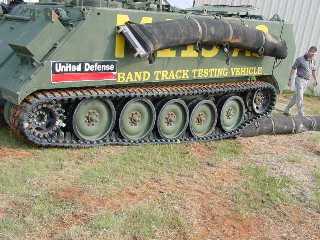
After years of lobbying, the U.S. Army this year finally authorized its Soldiers to wear "Camel-Bak" water drinking bladders to keep them hydrated and mission capable rather than heat casualties. In stylish camouflage colors, "Camel-Baks" are empowering our troops in Afghanistan and Iraq so they can drink-on-the-move; form has finally caught up with function.
However, it is not just fighting Soldiers that have an appetite for liquid replenishment--so do the Army's many ground vehicles that until now have been a pain to maintain with fuel. In WWII, Army M3 Stuart light tanks had two jettisonable 25 gallon drums of fuel to keep them rolling across North Africa, Italy and France. Russian T-34 tanks had fuel barrels attached to their rear to accomplish the same thing: double their range. The drawback in these efforts was the slow transfer of fuel from the inflexible steel drums into the vehicle's tanks.
Today, a Bridgeport, West Virginia company, FMW Composite Systems, Inc., has solved this dilemma and has created a "Camel-Bak" type system for tanks---called "FLEXCEL." Like the bladders our Soldiers use, FLEXCEL is pressurized to flow liquids where its needed, except its not air pressure but the weight of the vehicle's own tracks pressing down that pumps the fuel into its tanks.
What is FLEXCEL?
The FLEXCEL Liquid Containment system is a self-contained liquid storage system which can rapidly dispense its contents (fuel, water, decontaminants, oil, etc.), from a rubber bladder for military and/or commercial use and has been sole-sourced by FMW to the Department of Defense. This liquid containment system is available in 55 and 80-gallon configurations and requires no special equipment or training, making it the simplest way to move and use liquids. Uses include helicopter and aircraft transports, M1A1 Abrams tanks, M2 Bradley, M113 Gavin infantry fighting vehicles and other vehicular refueling capabilities. Field refueling is FLEXCEL's specialty. Units can be airdropped, without a parachute, to military tanks and armored personnel carriers. This system also transports and delivers oil, other fuels and several decontaminants. With no moving parts, high reliability and re-usability, FLEXCEL has been tested extensively and is in the U.S. Army and U.S. marine corps inventory. One example of such testing was a Production Validation Test (PVT) of the FLEXCEL at the U.S. Army Yuma Proving Ground during the period of November 1995 to April 1996.
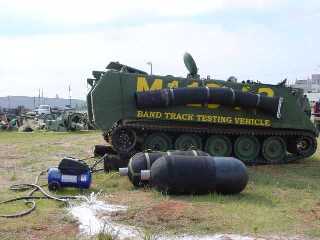
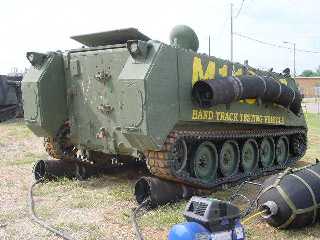
FLEXCEL kits are currently available in 55 and 80-gallon sizes. A kit consists of two bladders each, with two 20’ x 1" dispensing hoses and a harness assembly for mounting the bladders onto vehicles. Modifications to the system can be made for commercial use. This system has been tested and used by the U. S. military and foreign militaries, has a long-term shelf life and is reusable. FLEXCEL can operate in extreme temperatures and environmental conditions ranging from arctic to desert. During Operations Desert Shield and Desert Storm, FLEXCELs were deployed in combat conditions with the Army’s 3/73rd Armor Battalion which used M551 Sheridan light tanks and M113 Gavin command post airdroppable vehicles to support the primarily foot-mobile 82nd Airborne Division. In after action reports, the Battalion Commander indicated the FLEXCEL was a "life saver" and was often his "only supply of fuel" outside the garrison. Earlier this year, FMW completed another FLEXCEL production contract of the 80-gallon variant for foreign military sales for use with their tank units. USMC LAR units used FLEXCELs in combat in Iraq.
In addition to and as a natural progression from FLEXCEL, FMW manufactures a slightly different variant referred to as the FAST (Forward Area, Self-contained, Transportable) system. Similar to FLEXCEL, FAST also serves as a liquid containment and dispensing system and is currently manufactured from the same rubber compounds in 100, 200, and 300-gallon variants. FAST systems do not require the weight of a ground vehicle to dispense their contents; rather they operate by the application of compressed gas or air within a range of 3-20 p.s.i. and a flexible diaphragm built into the bladders to refill aircraft like Army helicopters and wheeled vehicles. Employment of the FAST requires no special tools, training or large pump. The system can be placed into operation using an air compressor already resident on a tactical vehicle, a SCUBA tank, or even a manual foot pump. Ideally suited for remote sites or use by small units, the FAST system is user friendly, rugged, re-usable, and collapsible.
FLEXCEL Deployment Concept
FLEXCEL is either tied to the side of the turret of the vehicle (not preferred method), laid across the back deck or the best place on the vehicle sides/skirts like on the M113A3 Gavin. Another option is carry FLEXCELs in a trailer or back of vehicle on a PLS flat rack.
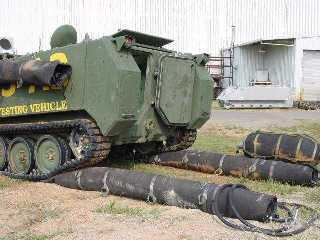
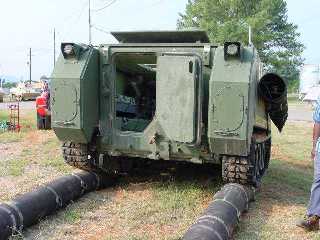
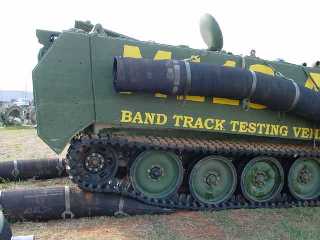

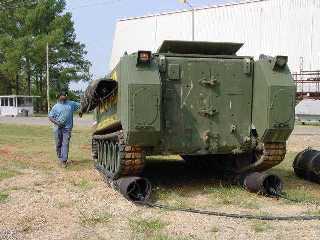
It can dispense fuel by gravity feed or can be dropped onto the ground, positioned behind the tracks and the vehicle is guided up on the bag. While the hose is inserted in the vehicle fuel tank, the weight of the vehicle serves as a pump and forces the liquid contents from the bladder, through the hose and into the vehicle’s fuel cells.
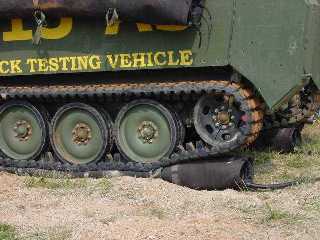
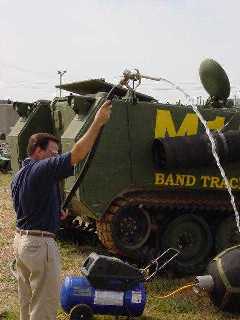
Upon completion of the fueling operation, the bladder can be recovered by the vehicle crewmen or later recovered by follow-on logistics trains for reuse. The FLEXCEL is not intended to remain attached to a vehicle during battle or when taking surprise fire. As the vehicle commander secures his hatch in response to incoming fire, he can jettison the bladders using the quick disconnect straps of the harness assembly. The FLEXCEL is built to survive a 30-foot drop to the ground. The primary use of the FLEXCEL is in the movement of armor from staging areas up to the Line of Departure (LD), where the bladders are jettisoned and top off the vehicle's tanks prior to movement-to-contact. As depicted, heavy-duty Clevis straps are used to affix the bladders to the side of the vehicle.
Fuel in FLEXCELs are contained in flexible, filament reinforced rubber tubes that strap to the sides of an armored fighting vehicle like the United Defense M113A3 Gavin loaded to 15 tons with 60+ mph stealthy "band tracks" depicted here. When its time to replace the 95 gallons of fuel normally carried in its twin external tanks, the Soldier in command releases the two 55-gallon FLEXCELs hanging along the vehicle sides, backs the Gavin up and runs over the two bladders with his tracks to send fuel through two hoses into the twin armored tanks. The Gavin now has in a few minutes another 300 miles of range! FLEXCEL places fuel where the vehicle commander needs it; readily available and not "on call." It may mean the difference between carrying the fight forward or becoming a stationary target.
How FLEXCELs can transform the U.S. Army
With FLEXCELs, Army mission planners can automatically double the range of any tracked vehicle--this may mean not having to endanger any refueling trucks and Soldiers driving into unsecured areas to keep maneuver forces moving towards achieving decisive effects. If refueling has to be done and the vehicle's onboard fuel and external FLEXCELs are used up, more FLEXCELs can be delivered to them via helicopter or fixed-wing aircraft, again without the complication of needing specially trained refueling personnel and pumping equipment. Some of the Army's more innovative Light Infantry units are using flexible 5 gallon water bags for bulk resupply in a similar manner.
The transformed U.S. Army must be able to rapidly deploy with lighter logistics! FLEXCELs--Camel-Baks for tanks--are the way to go farther and faster to hit the enemy where he expects it least. Logistics planners suggest that fuel and water comprise nearly 70% of the logistics challenge on the modern-day battlefield. FLEXCEL and FAST provide an expeditious solution to ease some of those challenges.
For more info on FLEXCELs or FAST, contact:
Michael C. MAYNARD
FMW Composite Systems, Inc.
1200 West Benedum Industrial Drive
Bridgeport, West Virginia 26330
Phone: (304) 842-1970 / Fax: -1972
E-mail: mmaynard@fmwcomposite.com
WWW: www.fmwcomposite.com/flexcel.asp
or
Jennifer MORTON
FMW Composite Systems, Inc.
168 West Main Street, Suite 600
Clarksburg, West Virginia 26301
(304) 624-8028 / Fax: -0170
E-mail: jmorton@fmwcomposite.com
WWW: www.fmwcomposite.com/flexcel.asp
